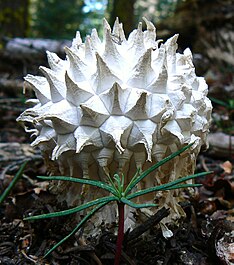Calvatia sculpta
| Calvatia sculpta | |
|---|---|
 |
|
| Scientific classification | |
| Kingdom: | Fungi |
| Division: | Basidiomycota |
| Class: | Agaricomycetes |
| Order: | Agaricales |
| Family: | Agaricaceae |
| Genus: | Calvatia |
| Species: | C. sculpta |
| Binomial name | |
|
Calvatia sculpta (Harkn.) Lloyd (1904) |
|
| Synonyms | |
|
|
| Calvatia sculpta | |
|---|---|
| Mycological characteristics | |
| glebal hymenium | |
| no distinct cap | |
| spore print is brown | |
| ecology is mycorrhizal | |
|
|
edibility: edible or choice |
edibility: edible
Calvatia sculpta, commonly known as the sculpted puffball, the sculptured puffball, the pyramid puffball, and the Sierran puffball, is a species of puffball fungus in the family Agaricaceae. Attaining dimensions of up to 8 to 15 cm (3.1 to 5.9 in) tall by 8 to 10 cm (3.1 to 3.9 in) wide, the pear- or egg-shaped puffball is readily recognizable because of the large pyramidal or polygonal warts covering its surface. It is edible when young, before the spores inside the fruit body disintegrate into a brownish powder. The spores are roughly spherical, and have wart-like projections on their surfaces.
Originally described from the Sierra Nevada, C. sculpta is found in mountainous areas in western North America, and was found in a Brazilian dune in 2008. It may be easily confused with Calbovista subsculpta, a similar puffball that—in addition to differences observable only with a microscope—is larger, and has slightly raised warts with a felt-like texture. Other similar species include Calvatia arctica and immature specimens of Amanita magniverrucata.
The species was first described in 1885 by American mycologist Harvey Willson Harkness, under the name Lycoperdon sculptum. Harkness, who called it "a curious and strikingly beautiful species", found fruit bodies growing at elevations between 1,800 and 2,400 meters (5,900 and 7,900 ft) in the Sierra Nevada mountains. Although he noted that "in appearance it differs so much from any species known to us, as to be almost deemed worthy of generic rank", he thought that placement in the puffball genus Lycoperdon was the most appropriate classification, despite its unusual cortex. Harkness's type collections were destroyed in the fires following the 1906 San Francisco earthquake. In 1904, Curtis Gates Lloyd considered the species better placed in Calvatia, because of the resemblance of its deeply colored capillitial threads (coarse thick-walled cells found in the gleba) to those of Calvatia caelata; he called the species Calvatia sculptum. The mushroom is known by several common names, including the "sculpted puffball", the "sculptured puffball", the "pyramid puffball", and the "Sierran puffball".
...
Wikipedia
